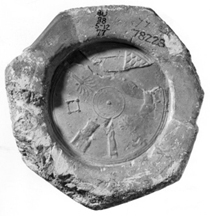You are seeing an unstyled version of this site. If this is because you are using an older web browser, we recommend that you upgrade to a modern, standards-compliant browser such as FireFox [http://www.getfirefox.com/], which is available free of charge for Windows, Mac and Linux.
RINAP Sources

BM 78223 (text no. 115), a fragment of clay prism of Esarhaddon recording the rebuilding of Babylon and Esagil with Assyrian hieroglyphs stamped on its top. © Trustees of the British Museum.
The 676 Neo-Assyrian royal inscriptions [http://oracc.museum.upenn.edu/rinap/corpus/] presently published by the RINAP Project (2011–18) are known from 2,249 objects. These texts, nearly all of which are composed in the Standard Babylonian dialect of Akkadian, are written on a wide variety of clay [http://oracc.museum.upenn.edu/rinap/sources/textslistedbyobjecttype/index.html#clay], metal [http://oracc.museum.upenn.edu/rinap/sources/textslistedbyobjecttype/index.html#metal], and stone [http://oracc.museum.upenn.edu/rinap/sources/textslistedbyobjecttype/index.html#stone] objects. These inscribed artifacts were discovered throughout the Near East and eastern Mediterranean, in the ruins of numerous Assyrian (especially Aššur, Calah, and Nineveh) and Babylonian (in particular, Babylon, Nippur, and Uruk) cities, as well as on difficult-to-reach rock faces, victory steles, and on the facing stones of canals and aqueducts. Many of the inscriptions recording the accomplishments of Assyria's last rulers are now housed in numerous museum [http://oracc.museum.upenn.edu/rinap/sources/indexofmuseumnumbers/index.html] and private collections around the world; the most notable collections with late Neo-Assyrian royal inscriptions are the British Museum [http://www.britishmuseum.org] in London, the Louvre [http://www.louvre.fr/en] in Paris, the Oriental Institute Museum of the University of Chicago [https://oi.uchicago.edu/museum-exhibits] in Chicago, and the Vorderasiatisches Museum [http://www.smb.museum/en/museums-and-institutions/vorderasiatisches-museum/home.html] in Berlin.
This sub-project of RINAP Online includes transliterations of the available sources for the 676 editions of late Neo-Assyrian royal inscriptions published in RINAP 1 [http://oracc.museum.upenn.edu/rinap/rinap1/corpus/], RINAP 3 [http://oracc.museum.upenn.edu/rinap/rinap3/corpus/], RINAP 4 [http://oracc.museum.upenn.edu/rinap/rinap4/corpus/], and RINAP 5 [http://oracc.museum.upenn.edu/rinap/rinap5/corpus/]. To access the individual object transliterations, click here [http://oracc.museum.upenn.edu/rinap/sources/pager/] or click on the "Browse Online Corpus" link to the left. For catalogues of the sources on which the inscriptions of Tiglath-pileser III, Shalmaneser III, Sennacherib, Esarhaddon, Ashurbanipal, Aššur-etel-ilāni, and Sîn-šarra-iškun were written, click on the links to the left or on the following links: Index of Museum Numbers [http://oracc.museum.upenn.edu/rinap/sources/indexofmuseumnumbers/index.html], Index of Excavation Numbers [http://oracc.museum.upenn.edu/rinap/sources/indexofexcavationnumbers/index.html], Index of Excavation Photograph Numbers [http://oracc.museum.upenn.edu/rinap/sources/indexofexcavationphotographnumbers/index.html], and Texts Listed by Object Type [http://oracc.museum.upenn.edu/rinap/sources/textslistedbyobjecttype/index.html]. Those pages include: (1) museum/registration (accession) numbers for the forty-two museums in which the inscribed objects edited here are housed; (2) excavation (field) numbers for eight ancient sites (especially Aššur, Babylon, Calah, and Uruk); (3) excavation photograph numbers for the German excavations at Aššur, Babylon, and Uruk; and (4) a complete list of twenty-seven different types of clay, metal, and stone objects upon which Neo-Assyrian royal inscriptions are known to have been inscribed on.
The corpus of edited texts in this RINAP sub-project presently includes:

The RINAP Project has been made possible in part by major grants from the National Endowment for the Humanities: Exploring the human endeavor. Any views, findings, conclusions, or recommendations expressed on this website do not necessarily represent those of the National Endowment for the Humanities.